#but THE REAL TIP IS HONESTLY THE LASSO TOOL
Explore tagged Tumblr posts
Note
how long does it take you to draw your sketches/doodles? also do you have any tips to draw faster? 🙇♀️
I generally take 30 - 60 minutes a sketch,,,, but honestly really depends on how detailed it is.
Like a Chibi will be done in 20 - 25 minutes (Counting in the extra time I spend on minute details like a perfectionist 😭)
I for some reason really like spending egregious amounts of time on random objects too??? Unless it’s the in the background, I’ll spend 40 minutes refining it.
Random characters that are fully colored and rendered with take like 80 minutes.
The comics take usually take an hour or two per page. (If I decide to cross hatch it, my entire day will be gone with 4 pages… so I’ve been trying to find shortcuts. But not without sacrificing the quality for time lol)
I don’t think there’s any trick or magic to drawing faster. It’s really about weaponizing your artistic knowledge, and finding what’s comfortable or convenient for you!
There was a period of time where I would spend 11 or 12 hours on an illustration, and it wASS UGLYYYYY. (Some of these artworks are still available on my tumblr,,, but it’s SO LONG AGO, AND IT WAS MY 1ST OR 2ND YEAR GETTING INTO DIGITAL ART)
Overtime I learned what worked best for me, and practiced till I felt more comfortable with what I was drawing. Eventually I managed to shorten the time to 4 hours or less! Ambition was my biggest enemy but at the same time my biggest motivator. (And it still is LMFAO) 😭
EDIT (bit more to my way too long tangent): ALSO??? BRO DON’T BE AFRAID TO USE YOUR MESSY SKETCH AS LINEART OR DRAW ON TOP OF IT. I’VE DONE IT FOR YEARS NOW AND IT ADDS SUCH A GOOD EXTRA BIT OF TEXTURE,, AT THIS POINT I DON’T EVEN USE LINE-ART ANY MORE UNLESS IT’S A COMMISSION,, (IT’LL ADD LIKE AN 2-4 HOURS TO MY WORK)

#mushyrt#asks#that word minute bothers me so much#I look at it and want to refer to it as the time minute#this sketch took about 3 minutes when it should’ve been 1 minute#BUT I WAS SO HYPERFIXATED ON THE EYESSS#i say these pretty words#but THE REAL TIP IS HONESTLY THE LASSO TOOL#LASSO TOOL IS THE BEST#IT’S MY FAVORITE TOOL FOR MAKING BACKGROUNDS OR QUICK SHADING OR COLORING#OR ALSO THE MASK TOOL#TAKE ADVANTAGE OF THEM#THEY’RE SO GOOD#Procreate mask tool kinda sucksss#SO USE ALPHA LOCK IF YOU ARE A CONFIDENT PERSON#OR NOT AFRAID TO F**K UP#Bro I sometimes draw on 1 layer and use alpha lock and my friends look at me like I’m a menace#BUT IT!S USEFULLLL AND SO EASY#This little tangent definitely should’ve been my answer for the ‘how much do you draw’ question#but I’ve been thinking about it for a long time#AND I’M A MANIAC WHEN IT COMES TO DRAWING 😭😭#even if you rob me of a paper or pencil I WILL FIND A WAY TO DRAW#I WILL SCRATCH INTO YOUR SHIRT AND ROCKS AND MAKE AN ARTWORK OUT OF WATER OR CAT FUR#YOU WILL NOT DEPRIVE ME OF MY CREATIVE ENDEAVORS#This didn’t stick out to me until one of my friends said ‘omg ofc she’s drawing’ under her breath#like I spend every second of free time I have drawing unless I find something else interesting#The only time I’m not drawing is when I’m on the toilet or doing random everyday stuff#I forgot to talk about this but greyscale to color is insanely useful too; it teaches you different values while also being super fast#i tend to use greyscale to color when I do a BW sketch I end up liking#TL;DR - Lasso Tool + Layer Mask + Alpha Lock + Sketch as lineart
59 notes
·
View notes
Note
would it be dumb if i complimented how well you draw paper
in that little teaser thing you posted i uaghuag
i struggle with patterns on like folds and stuff, like paper/posters and it always looks so flat so im. here to say yours looks nice. proportional...? questionmark?
that is all iM SO HYPED
AHAHA THABK YOU!!
Paper can be a funny material to draw… Honestly, depending on a few things, drawing a flat rectangle on a wall is still realistic!

When I drew the credits paper, I started by thinking of its pin point (aka: what is holding the paper and how rough did it stab the paper) and then drawing the outline of the paper based on that. Then, the folds/creases come after.
For example, if a small thumbtack was carefully pinning the paper, there wouldn’t be any notable creases compared to someone stabbing a knife to pin a paper!
Those creases tend to have triangular shapes also. No matter what has tampered with the paper, there is always some triangles there.
Sometimes, drawing the creases isn't necessary, because SOMETIMES, it's a pain to manually do. An example of this is crumbled paper being unfold. It's hard to draw everything!
So, my quick tip is do draw the outline with shaky lines and then either:
shade in the creases with an airbrush and lasso tool OR
download a crumbled paper texture png and then insert it in
(see bottom left in picture)
I guess one thing to note is that you’d want to avoid making paper look floppy… because it’s not a piece of cloth, it’s weightless, thin, and can hold its shape pretty well! An exception to this would be when the paper is wet (because the water is now giving it weight/gravity).
When there's a pattern/text on a fold, it can get tricky. I usually just misalign the pattern to the side or down though, and you have to think about the pattern that's under the fold too. In my opinion, it's one of those things where you may have to sketch it on a real piece of paper as your reference!
If you can’t add any to the poster for xyz reasons, maybe what you need is some texture instead! Is it old? Is it laminated/shiny? Has it been folded before? Is it perfectly held up straight or is it tilting to the side? Is it covering other posters or is it being covered? Is it clean or smeared with grime? Lots of possibilities there....
I hope this help! I'm lazy so some of this is a "let's get this over and done with" tips; I think this is something you just constantly need a reference with hehe
#and unfortunately i am TOO lazy so i just visualise it in my mind and draw it off that#[ the askbox mourns ]#[ mourn's mourns ]#art tips#i'll add more example images or edit this later :3#[ mourn's resources ]
30 notes
·
View notes
Note
top 5 art supplies (digital and/or traditional)
1. CSP’s Real G-pen brush (this is literally all I use for drawing in CSP tbh. Then I use the lasso-fill tool for colouring, and the regular G-pen for bigger art pieces)
2. Honestly just mechanical pencils (0.5 mm)
3. 0.1/0.3 and fine tip ink pens is what I did for lineart back when my lineart used to be traditional (I like the DeSerres brand a lot. Also Micron and Kuretake pens)
4. When I used to colour in SAI this was my custom brush for everything

5. uhhh just cheap black/blue pens are fine for doodling
4 notes
·
View notes
Note
Hi! Do you have any tips on getting into digital art? I'm getting an art tablet soon, but I don't know where to begin. I want to draw animals if that helps
Congrats in advance on getting a tablet! I’m still pretty new to the whole digital art thing myself (I only got my first tablet like one-and-a-half years ago), but I’d be happy to give some tips on getting started!
1. Don’t try to create a masterpiece the first time you use the tablet. This might sound a bit obvious but the first thing you should do with a tablet is a lot of sketching and messing around to be able to get the feel of using a tablet, which can be a pretty unfamiliar sensation. If you expect yourself to be able to create a beautiful digital painting the first time you use a tablet, you’ll probably be disappointed. Just playing around with little sketches is a much better way to get accustomed to digital drawing.
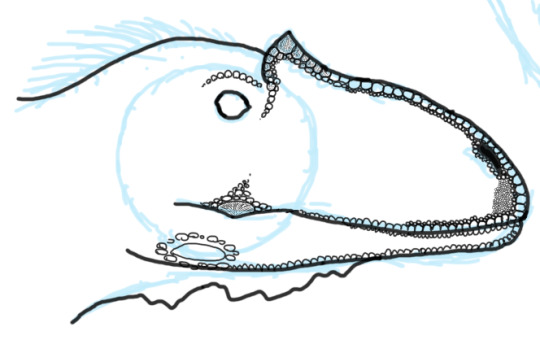
This is the first thing I ever drew with a graphics tablet. Just a sketch of an Allosaurus head with which I then proceeded to attempt an obscene amount of detail and gave up after I barely started. It’s okay to start small!
2. Play around with the brush settings in your art program. Most art programs have a wide variety of brush settings that you can fiddle around with to adjust size and transparency based on pen pressure, as well as different styles of brush that give different effects. I’d recommend messing around with these a bit while you’re doing your practise sketching to find a brush type that is most comfortable for your style of drawing.
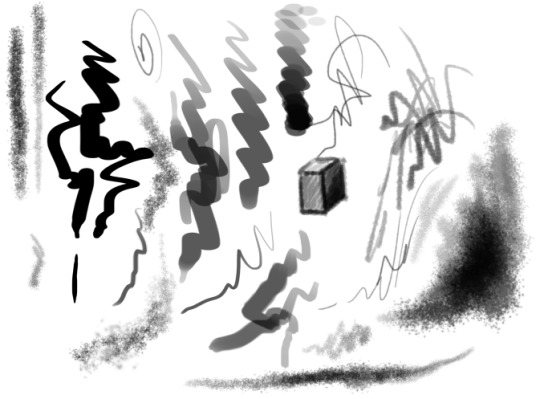
You can get a ridiculous amount of variation in brushes by fiddling around in the settings. I use Photoshop, but other drawing programs probably have similar tools. There are plenty of tutorials online on how to create your own personal brushes on different art programs, which can be a fantastic way to personalise your art and make it a bit more special.
3. Practice shading and highlights. One of my absolute favourite things about digital art is that it gives you the ability to easily create strong, bright highlights over your drawings, which is something that you just can’t do easily with a lot of traditional media such as coloured pencils. If you put in the time, effort, and practice to get this right, you can create really solid, three-dimensional-looking art. I can’t offer a lot of great advice on this since it’s still something that I’m working on myself, but there are plenty of tutorials on the internet on shading and highlighting in digital art that are really worth checking out and studying.
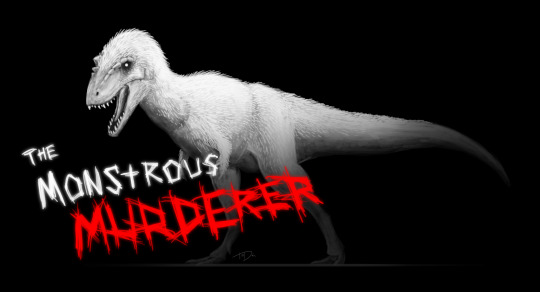
This Teratophoneus is probably one of my proudest achievements in shading and highlighting so far. The ability to draw light colours on top of pretty much anything is incredibly useful for creating good, solid highlights
4. Don’t feel pressured to be amazing at digital art immediately. There is definitely a learning curve to becoming good with a graphics tablet, and you almost certainly won’t be able to create beautifully-lit, photorealistic art right away. I’m still very early on in my digital art exploration, so I know that it can often be disheartening to see accomplished digital artists creating amazing pieces of art while you’re still trying to figure out how to use the lasso tool. The important thing to remember is that these artists probably have years more experience than you. That being said, if you put effort and care into practising digital art, you will improve at it, just like any other art form. Your first attempts will probably not be all that impressive, but your first attempts do not reflect what you will develop into as a digital artist.
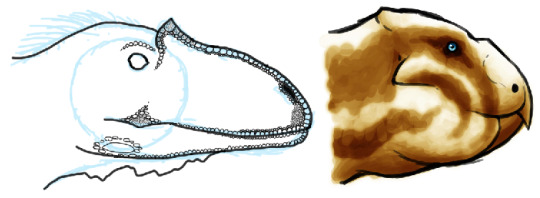
Two dinosaur heads, drawn by me, roughly 1.5 years apart. I only just found this really old drawing today, and I am honestly shocked by how far I’ve come. Art improvement might be hard to notice as it happens, but it’s so rewarding to look back and see where you came from.
And finally, the two most important ones (in my opinion):
5. Experiment with whatever you feel like. Digital art is an amazingly versatile medium. You can essentially make your artworks look like anything you want to. That can sound quite daunting, but it’s a great opportunity to spread yourself out and challenge yourself artistically. Want to draw something simple and cartoony? You can do that. Want to draw something so detailed it looks like a photo? You can do that too! Want to just go completely nuts with colours and see where it takes you? Guess what, you can also do that!
Don’t be afraid to try doing something new with digital art. I have at least three very different digital art styles that I can use interchangeably whenever I want it, and I feel like that’s the real power of digital art. The ability to create whatever you want to do, whenever you want to do it, however you want to do it. The ability to diversify and branch out and explore completely new styles and methods without having to worry about resources or media or buying lots of expensive pencils or paints that you might never use again. Whenever the mood strikes you, just sit down and start creating anything you want.
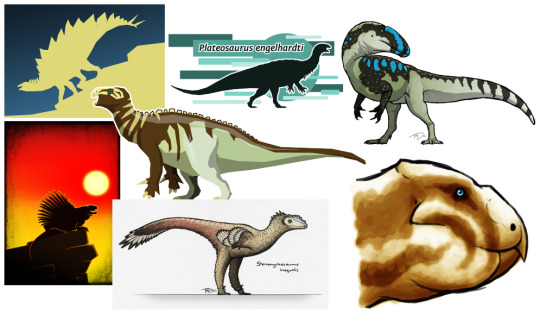
ABOVE: The many digital art styles of Tas. From abstract graphic design to realistic, anatomical illustrations, digital art is an incredibly broad medium.
6. Keep practising traditional art. This is something that I think is essential as an artist. Digital art should not take over any traditional art methods that you already use. Instead, it should be treated as something to expand your range, not replace it. I’ve raved about digital art quite a bit in this post, but to me there’s still nothing that feels better than a graphite pencil on a sheet of paper.
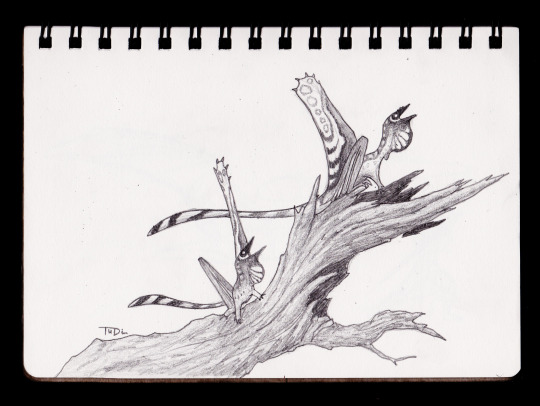
I drew a series of Triassic reptiles in graphite last year, and they remain some of my favourite restorations of prehistoric animals that I’ve ever done. Don’t underestimate the humble HB pencil.
The great thing about doing digital and traditional art is that one method informs the other. You might figure out some cool new technique with watercolours, graphite, coloured pencils, or whatever you prefer to use, and then use that same technique in your digital art. Likewise, digital art can also influence how you approach your traditional works. I have personally learned a lot more about shading since I started creating digital artworks, and I’ve been able to apply that knowledge to my traditional pieces as well.

This Bi-stahieversor is my most recent traditional artwork, and almost all of the shading and texturing techniques are based on things that I’ve learned from doing digital art. I highly doubt I would have been able to learn these as well if I hadn’t done a lot of shading practice in digital art.
Well, this has turned out to be significantly longer than I thought it would be. If anyone else has any other advice, please feel free to add it! I’m sure there are plenty of more experienced artists out there who have much more to teach than I could at this point in time.
Good luck with your new tablet, Anon, and best wishes in your artistic endeavours!
#ask#palaeoart#art#digital art#long post#I did not expect to write this much#but here we are I guess#hopefully this isn't too unreadable#art advice
132 notes
·
View notes